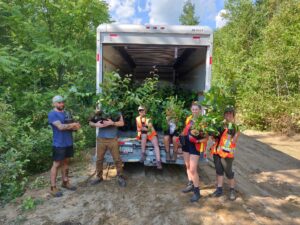Maples, oaks, willows and grasses touted to restore flood plains, reduce property damage and save wildlife
CBC News · Posted: Apr 12, 2021 5:02 PM AT | Last Updated: April 12

The spring melt is winding down on the St. John River and so far there’s been no major flooding.
The Public Safety Department reports the river is well below flood stage and the five-day forecast calls for levels to continue to drop. Experts in river restoration say there’s a way to increase the chance future freshets will go smoothly, too. Simon Mitchell of the World Wildlife Fund and Natalie Deseta of the Nashwaak Watershed Association say planting trees, shrubs and grasses along the river and its tributaries can help reduce the risk of bad flooding in spring and from extreme rain events.
“When we’re thinking about flooding,” said Mitchell, “our biggest issue is the frequency and intensity at which these events come.” Mitchell is a habitat specialist who studies the St. John River and a vice president with the Canadian WWF based in the Nackawic area.
“We need to do everything we can to hold the water on the landscape,” he said, “whether it’s trees or wetlands which act as a sponge and then slowly release that water.” Mitchell commends groups like the Kennebecasis Watershed Restoration Committee and the Nashwaak Watershed Association for the work that they have been doing.
Read the original article here.

